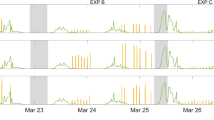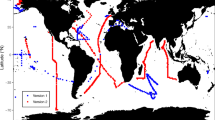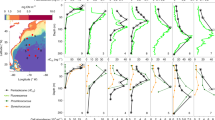Abstract
Polycyclic aromatic hydrocarbons, and other semivolatile aromatic-like compounds, are an important and ubiquitous fraction of organic matter in the environment. The occurrence of semivolatile aromatic hydrocarbons is due to anthropogenic sources such as incomplete combustion of fossil fuels or oil spills, and other biogenic sources1,2,3,4,5,6,7. However, their global transport, fate and relevance for the carbon cycle have been poorly assessed, especially in terms of fluxes3,5,8,9,10,11. Here we report a global assessment of the occurrence and atmosphere–ocean fluxes of 64 polycyclic aromatic hydrocarbons analysed in paired atmospheric and seawater samples from the tropical and subtropical Atlantic, Pacific and Indian oceans. The global atmospheric input of polycyclic aromatic hydrocarbons to the global ocean is estimated at 0.09 Tg per month, four times greater than the input from the Deepwater Horizon spill6. Moreover, the environmental concentrations of total semivolatile aromatic-like compounds were 102–103 times higher than those of the targeted polycyclic aromatic hydrocarbons, with a relevant contribution of an aromatic unresolved complex mixture. These concentrations drive a large global deposition of carbon, estimated at 400 Tg C yr−1, around 15% of the oceanic CO2 uptake12.
This is a preview of subscription content, access via your institution
Access options
Subscribe to this journal
Receive 12 print issues and online access
$259.00 per year
only $21.58 per issue
Buy this article
- Purchase on Springer Link
- Instant access to full article PDF
Prices may be subject to local taxes which are calculated during checkout




Similar content being viewed by others
References
Lima, A. L. C., Farrington, J. W. & Reddy, C. M. Combustion-derived polycyclic aromatic hydrocarbons in the environment—a review. Environ. Forensics 6, 109–131 (2005).
Melbye, A. G. et al. Chemical and toxicological characterization of an unresolved complex mixture-rich biodegraded crude oil. Environ. Toxicol. Chem. 28, 1815–1824 (2009).
Zhang, Y. & Tao, S. Global atmospheric emission inventory of polycyclic aromatic hydrocarbons (PAHs) for 2004. Atmos. Environ. 43, 812–819 (2009).
Cabrerizo, A. et al. Ubiquitous net volatilization of polycyclic aromatic hydrocarbons from soils and parameters influencing their soil–air partitioning. Environ. Sci. Technol. 45, 4740–4747 (2011).
Berrojalbiz, N. et al. Biogeochemical and physical controls on concentrations of polycyclic aromatic hydrocarbons in water and plankton of the Mediterranean and Black Seas. Glob. Biogeochem. Cycles 25, 1–14 (2011).
Reddy, C. M. et al. Composition and fate of gas and oil released to the water column during the Deepwater Horizon oil spill. Proc. Natl Acad. Sci. USA 109, 20229–20234 (2012).
White, H. K., Xu, L., Hartmann, P., Quinn, J. G. & Reddy, C. M. Unresolved complex mixture (UCM) in coastal environments is derived from fossil sources. Environ. Sci. Technol. 47, 726–731 (2013).
Nizzetto, L. et al. PAHs in air and seawater along a North–South Atlantic transect: trends, processes and possible sources. Environ. Sci. Technol. 42, 1580–1585 (2008).
Castro-Jiménez, J., Berrojalbiz, N., Wollgast, J. & Dachs, J. Polycyclic aromatic hydrocarbons (PAHs) in the Mediterranean Sea: atmospheric occurrence, deposition and decoupling with settling fluxes in the water column. Environ. Pollut. 166, 40–47 (2012).
Carpenter, L. J., Archer, S. D. & Beale, R. Ocean–atmosphere trace gas exchange. Chem. Soc. Rev. 41, 6473–6506 (2012).
Cabrerizo, A., Galbán-Malagón, C., Del Vento, S. & Dachs, J. Sources and fate of polycyclic aromatic hydrocarbons in the Antarctic and Southern Ocean atmosphere. Glob. Biogeochem. Cycles 28, 1424–1436 (2014).
Le Quéré, C. et al. Global carbon budget 2015. Earth Syst. Sci. Data 7, 349–396 (2015).
Park, J.-H. et al. Active atmosphere–ecosystem exchange of the vast majority of detected volatile organic compounds. Science 341, 643–647 (2013).
Yang, M. et al. Air–sea fluxes of oxygenated volatile organic compounds across the Atlantic Ocean. Atmos. Chem. Phys. 14, 7499–7517 (2014).
Dachs, J. et al. High atmosphere–ocean exchange of organic carbon in the NE subtropical Atlantic. Geophys. Res. Lett. 32, L21807 (2005).
Hauser, E. J., Dickhut, R. M., Falconer, R. & Wozniak, A. S. Improved method for quantifying the air–sea flux of volatile and semi-volatile organic carbon. Limnol. Oceanogr. 11, 287–297 (2013).
Ruiz-Halpern, S. et al. Ocean–atmosphere exchange of organic carbon and CO2 surrounding the Antarctic Peninsula. Biogeosciences 11, 2755–2770 (2014).
Lohmann, R., Breivik, K., Dachs, J. & Muir, D. Global fate of POPs: current and future research directions. Environ. Pollut. 150, 150–165 (2007).
Ma, Y. et al. Deposition of polycyclic aromatic hydrocarbons in the North Pacific and the Arctic. J. Geophys. Res. 118, 5822–5829 (2013).
Lammel, G. Polycyclic aromatic compounds in the atmosphere—a review identifying research needs. Polycycl. Aromat. Compd. 35, 316–329 (2015).
Hylland, K. Polycyclic aromatic hydrocarbon (PAH) ecotoxicology in marine ecosystems. J. Toxicol. Environ. Health Sci. A 69, 109–123 (2006).
Keyte, I. J., Harrison, R. M. & Lammel, G. Chemical reactivity and long-range transport potential of polycyclic aromatic hydrocarbons—a review. Chem. Soc. Rev. 42, 9333–9391 (2013).
González-Gaya, B., Zúñiga-Rival, J., Ojeda, M. J., Jiménez, B. & Dachs, J. Field measurements of the atmospheric dry deposition fluxes and velocities of polycyclic aromatic hydrocarbons to the global oceans. Environ. Sci. Technol. 48, 5583–5592 (2014).
Xu, Y. et al. The spatial distribution and potential sources of polycyclic aromatic hydrocarbons (PAHs) over the Asian marginal seas and the Indian and Atlantic Oceans. J. Geophys. Res. 117, D07302 (2012).
Duarte, C. M. Seafaring in the 21st Century: the Malaspina 2010 Circumnavigation Expedition. Limnol. Oceanogr. Bull. 24, 11–14 (2015).
Jurado, E. et al. Wet deposition of persistent organic pollutants to the global oceans. Environ. Sci. Technol. 39, 2426–2435 (2005).
Sarmiento, J. L. Ocean Biogeochemical Dynamics (Princeton Univ. Press, 2013).
Jurado, E., Dachs, J., Duarte, C. M. & Simó, R. Atmospheric deposition of organic and black carbon to the global oceans. Atmos. Environ. 42, 7931–7939 (2008).
King, G. M., Kostka, J. E., Hazen, T. C. & Sobecky, P. A. Microbial responses to the Deepwater Horizon oil spill: from coastal wetlands to the deep sea. Annu. Rev. Mar. Sci. 7, 377–401 (2015).
Chan, A. W. H. et al. Secondary organic aerosol formation from photooxidation of naphthalene and alkylnaphthalenes: implications for oxidation of intermediate volatility organic compounds (IVOCs). Atmos. Chem. Phys. 9, 3049–3060 (2009).
Berrojalbiz, N. et al. Accumulation and cycling of polycyclic aromatic hydrocarbons in Zooplankton. Environ. Sci. Technol. 43, 2295–2301 (2009).
Farrington, J. W. & Quinn, J. G. “Unresolved Complex Mixture” (UCM): a brief history of the term and moving beyond it. Mar. Pollut. Bull. 96, 29–31 (2015).
Donkin, P., Smith, E. L. & Rowland, S. J. Toxic effects of unresolved complex mixtures of aromatic hydrocarbons accumulated by mussels, Mytilus edulis, from contaminated field sites. Environ. Sci. Technol. 37, 4825–4830 (2003).
Bamford, H. A., Poster, D. L. & Baker, J. E. Temperature dependence of Henry’s law constants of thirteen polycyclic aromatic hydrocarbons between 4 °C and 31 °C. Environ. Toxicol. Chem. 18, 1905–1912 (1999).
Schwarzenbach, R. P., Gschwend, P. M. & Imboden, D. M. Environmental Organic Chemistry 2nd edn, 133–180 (John Wiley, 2003).
Burkhard, L. P. Estimating dissolved organic carbon partition coefficients for nonionic organic chemicals. Environ. Sci. Technol. 34, 4663–4668 (2000).
Nightingale, P. D., Liss, P. S. & Schlosser, P. Measurements of air–sea gas transfer during an open ocean algal bloom. Geophys. Res. Lett. 27, 2117–2120 (2000).
Livingstone, D. M. & Imboden, D. M. The non-linear influence of wind-speed variability on gas transfer in lakes. Tellus B 45, 275–295 (1993).
Costello, M. J., Cheung, A. & De Hauwere, N. Surface area and the seabed area, volume, depth, slope, and topographic variation for the world’s seas, oceans, and countries. Environ. Sci. Technol. 44, 8821–8828 (2010).
Spivakovsky, C. M. et al. Three-dimensional climatological distribution of tropospheric OH: update and evaluation. J. Geophys. Res. 105, 8931–8980 (2000).
Acknowledgements
This work was funded by the Spanish Ministry of Economy and Competitiveness (Circumnavigation Expedition Malaspina 2010: Global Change and Biodiversity Exploration of the Global Ocean. CSD2008-00077). B.G.-G. and M.-C.F.-P. acknowledge a predoctoral fellowship from BBVA Foundation and the Spanish National Research Council (CSIC), respectively. CSIC and the Spanish Government are also acknowledged for additional financial support. Thanks to RV Hespérides staff and UTM technicians during the cruise. D. García, G. Caballero and M. J. Ojeda are acknowledged for collaborating in the laboratory work.
Author information
Authors and Affiliations
Contributions
B.G.-G. participated in the sampling campaign, analysed the samples, estimated the fluxes and wrote the paper. J.D. participated in the sampling campaign and designed the sampling strategy and work, estimated the fluxes, and wrote the paper. C.M.D. led the Malaspina 2010 project and coordinated the overall sampling strategy for the project. L.Mé contributed in the chemical identification. M.-C.F.-P., L.Mo and B.J. participated in the sampling campaign. All authors have contributed to the discussion of the results and commented on the final version of the manuscript.
Corresponding author
Ethics declarations
Competing interests
The authors declare no competing financial interests.
Supplementary information
Supplementary Information
Supplementary Information (PDF 2529 kb)
Rights and permissions
About this article
Cite this article
González-Gaya, B., Fernández-Pinos, MC., Morales, L. et al. High atmosphere–ocean exchange of semivolatile aromatic hydrocarbons. Nature Geosci 9, 438–442 (2016). https://doi.org/10.1038/ngeo2714
Received:
Accepted:
Published:
Issue Date:
DOI: https://doi.org/10.1038/ngeo2714
This article is cited by
-
Metatranscriptomic responses and microbial degradation of background polycyclic aromatic hydrocarbons in the coastal Mediterranean and Antarctica
Environmental Science and Pollution Research (2023)
-
Performance analysis of Pseudomonas sp. strain SA3 in naphthalene degradation using phytotoxicity and microcosm studies
Biodegradation (2022)
-
Anthropogenic dissolved organic carbon and marine microbiomes
The ISME Journal (2020)
-
In situ growth of metal-organic framework HKUST-1 in an organic polymer as sorbent for nitrated and oxygenated polycyclic aromatic hydrocarbon in environmental water samples prior to quantitation by HPLC-UV
Microchimica Acta (2020)



